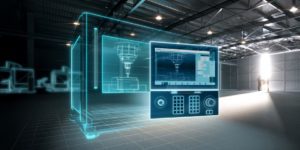Application-Oriented Laser Melting
The automatic sieving station continuously safeguards the powder quality and thus the component quality too.
Posted: September 16, 2013
Mold inserts with close-contour cooling and a hybrid build style may improve the quality and cycle element in the case of sophisticated injection-molded parts.
Erwin Gottschall founded LPT (Paderborn, Germany) in 1995 to provide working resources in metal, aluminium and special materials. It very quickly became apparent that mold-makers are shirking welding, but like to make use of this as a service.
In addition, Gottschall recognized the significance of laser technology at a very early stage and relied on the fact that the mold-maker generally does not wish to apply the process of generative laser melting itself. Firstly this is because the technology requires specific knowledge and secondly also because capacitively it cannot always be used in an economically viable way by the mold-makers. LPT filled this gap in the market.
12 branch offices and a technical facility for metal laser melting in Schleiz now bear testament to the level of acceptance the firm enjoys within the sector. Depending on the particular site, components weighing up to 5,000 kg can be processed. Over 2000 customers place their trust in the technical possibilities offered by LPT.
Expertise which Erwin Gottschall justifies by offering a customer-focussed consulting service: “For certain applications, we recommend that the customer uses conventional technology if this is more efficient. If our welding technology offers advantages, then we offer them. When it comes to close-contour cooling, we familiarize the customers with the artistic possibilities that LaserCUSING offers in collaboration with Concept Laser. The aim is to offer a method which is as effective as it is economical. A sensible product then.” According to what he says, the firm differs from the competition because of the technology-independent advice and execution it is able to offer.
Gottschall brings his experience from many years spent working in plastics processing and he knows what should happen in the cavity. Lutz Frötzschner is in direct contact with the customer and he looks after all aspects of component design, construction, welding technology and LaserCUSING right through to working out the close-contour cooling. The strategic partnership with Concept Laser plays a pivotal role for the service provided at LPT.
LPT was one of the first companies back in 2004 to invest in a Concept Laser M3 linear machine for manufacturing large laser melted components and small batches. Over the course of recent years, the metal laser melting technology has made enormous development strides in terms of laser power, pace of construction and component quality. To ensure that the company could continue to remain competitive in the area of generative metal laser melting in the future, in 2010 the company invested in an M1 cusing machine which is very much state of the art.
The equipment at the technical facility in Schleiz was completed with the addition of a QM Powder module. The automatic sieving station continuously safeguards the powder quality and thus the component quality too. Lutz Frötzschner cites the motivation as being to ensure the component properties which are required in mold-making and tool-making in the areas of density and surface quality. According to him, the Schleiz site is thus ideally equipped to cater for all of its customers’ requirements.
When it comes to boosting performance and exploiting the options available, the training measures of Concept Laser are very important for keeping LPT in good shape. In the case of complex cooling-channel designs, Concept Laser provides support with its constructive experience from its own mold-making.
For instance, the firm utilizes the CAD training course “Conformal Cooling” for the purpose of applying the cooling-channel design of Hofmann in Lichtenfels. Suppliers and users also maintain close contact in respect of maintenance concepts on the LaserCUSING machines. Further developments, retrofitting options and software updates complete the concept behind such a partnership.
The formative residual geometry including the remaining cooling-channel design can be “fused” onto a prefabricated basic body, with predrilled feed and drain holes for the cooling, by means of LaserCUSING. This procedure is patented by Concept Laser. According to LPT, this mixed type of construction has already proven to be the fastest and most economical method in many cases.
According to Gottschall, a very important aspect is the principle of close-contour cooling from Concept Laser which begins 2 to 3 mm below the mold contour. There are a very wide range of forms for the cooling-channel design. The most proven and most frequently used cooling-channel variants are surface cooling and parallel cooling. Whereas close-contour cooling with one channel may be sufficient for normal parts, close-contour parallel cooling with several short cooling circuits may improve the quality and cycle element in the case of sophisticated injection-molded parts.
With parallel cooling, more coolant is delivered to the cavity or surface of the molded part than is the case through a long cooling channel. For with a long cooling channel the cooling effect diminishes continuously as the distance increases. Furthermore, with parallel cooling each cooling loop is supplied with fresh cooling medium, which leads to optimum cooling. The result is thus dynamic and even cooling.
“The use of the respective technology depends on the geometry of the component. We have to assess this on a constructive basis,” says Erwin Gottschall. He estimates that the potential for improvement here is as much as 50 percent. The injection process is shortened as a result and the component is thus much faster in cycle.
In addition, warping in the polymer reduces as a result of these methods. The parallel and surface cooling is a patent which has been granted to Werkzeugbau Siegfried Hofmann GmbH. LPT GmbH automatically receives a license to make use of the patent with the purchase of the LaserCUSING technology.
Stettiner Straße 34 33106 Paderborn, Germany, +49 5251 750134, www.concept-laser.de














